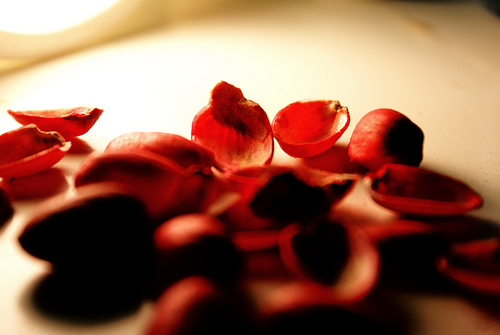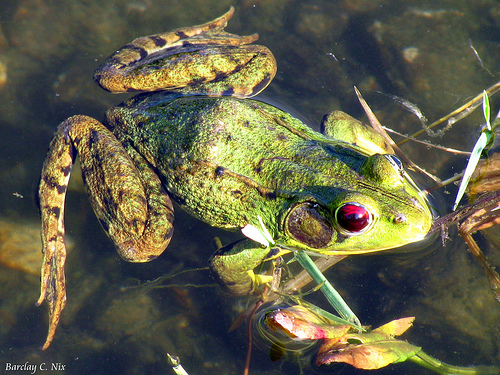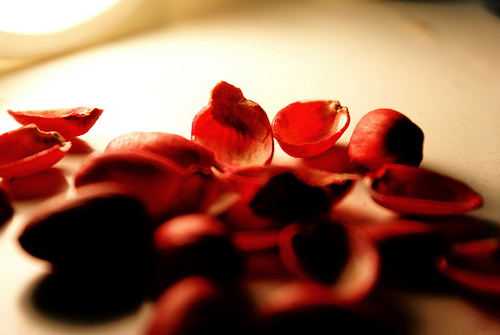 Pistachios: What shell remain? Photo: PatternedCross-posted from Cool Green Science.
Pistachios: What shell remain? Photo: PatternedCross-posted from Cool Green Science.
What won’t climate change affect? Well, cross trail mix and cherry pie off that ever-shrinking list. It turns out that crisp apples, chewy almonds, ripe plums, and a host of other nuts and stone fruits might become much more costly to grow — or not grown at all in some spots — because of rising winter temperatures, according to a new study published in the peer-reviewed journal PLoS One.
The problem, say researchers: The trees that produce these goodies need a certain number of hours at cold temperatures — or “winter chill” — in order to blossom and produce maximally. And the author’s extensive climate change modeling shows achieving adequate winter chill will become increasingly more difficult in growing zones across the world, from South Africa to southern Australia to California’s Central Valley. (The U.S. fruit and nut industry generates about $93 billion in income annually.)
That could mean lower crop yields unless growers either take either costly measures to adapt to warmer winters or move their stocks northward — a forced migration that might not work in many cases, according to Nature Conservancy climate scientist Evan Girvetz, a coauthor on the study. I asked Girvetz to serve up the nutty details (look out, pistachio lovers!) and to talk about how he as a climate scientists deals with depressing studies like this coming out nearly every week.
 Climate scientist Evan Girvetz.Q. What’s the issue here — that fruit and nut trees need lots of cold weather before they can flower properly?
Climate scientist Evan Girvetz.Q. What’s the issue here — that fruit and nut trees need lots of cold weather before they can flower properly?
A. Yes, many fruit and nut trees, such as cherries, apples, apricots, walnuts, and almonds, require cold weather during the winter and early springtime to cue the trees to flower and produce good yields of fruits and nuts. These trees have evolved in areas that freeze, and they go dormant during the winter to protect themselves from frost damage. In order to know when to come out of dormancy, they internally keep track of the amount of cold that has occurred over winter. Once a certain amount of chilling has occurred, the plants break dormancy and flower. When there is insufficient cold weather, the trees do not properly break dormancy, often causing reduced yields and even complete crop failures in some years.
Q. We hear a lot about oranges going bad in Florida freezes. But who knew nuts and stone fruits could be really vulnerable — to too much winter warmth?
A. Most species of stone and pome fruits, as well as most nuts we eat, originate from regions with very cold winters, such as Central Asia and the Middle East. Protection from frost has thus been vital during their evolutionary process — so vital that there has been little success in breeding cultivars without a chilling requirement.
Today, the major growing regions of these crops are in very different climatic zones, where winters are relatively warm, compared to the harsh conditions in the original ranges of the species. Many species are only marginally suited to where they are grown, and even small changes in temperature patterns can be a problem. Rising temperatures caused by climate change may reduce winter chill enough to cause serious problems for fruit and nut tree yields, especially those grown in the warmer growing regions, such as in California, Chile, the Middle East, China, Africa, and Australia.
Q. Any crops we should be especially worried about?
A. It depends upon where you are in the world, but in California, for example, I’d be worried about pistachios, walnuts, plums, and peaches, as it looks like there will not be suitable climate there for them by the end of this century. In Chile, from where we in the U.S. get fruit during the winter, peaches and cherries are projected to be impacted by climate change. The problem is that in every growing region of the world, tree species are selected to match the local temperature pattern. So it’s quite possible that all important growing areas will have to make some adjustments.
Q. California’s Central Valley: some big potential impacts there. The paper says that the ecological niche of many fruits and nuts there could move northward, to northern California, Oregon, and Washington … but that it’s not as simple as just picking up and moving to a new state. Why not?
A. It certainly is not simple to move crops. First, the soils and lands in Oregon and Washington are inferior to those in California for growing these fruit and nut trees. Add to that, water limitations for agriculture in Oregon and Washington, which make it difficult to expand agriculture. And finally, it is a big economic cost to move a crop from one place to another — given land prices and the cost of starting a whole orchard from scratch, there is a huge up-front investment to move, especially given the often-small margin for profit in these agricultural industries.
Q. Where else might crop migration be difficult?
A. Migration of tree crops will be difficult everywhere. While farmers of annual crops can choose to grow something new every year or look for land elsewhere, tree crop growers are locked into their investments for several decades. The up-front costs of establishing an orchard must be recovered, and few growers will be ready to uproot their trees and start over elsewhere.
Besides, climate is only one factor that determines a region’s suitability for tree crops. They often require irrigation, they need certain soils, and processing infrastructure for fruits and nuts must be in place. We currently find highly efficient production systems in areas, where all these factors come together, such as in California’s Central Valley. For those reasons, it may be easier to find new crops for current growing regions than new growing regions for current crops.
Q. Now, growers of these crops have some ways to adapt, right? But what might the drawbacks of those methods be?
A. There are some things that growers can try to do to minimize the impacts of climate change on their crops, but all will cost money and they may not always work. There are chemicals that can be used to promote tree flowering, but too little is ineffective and too much damages the plants. Some of these chemicals are also quite toxic, and reliance on such materials may not be desirable. Agricultural management can help create cooler microclimates, but this is difficult and increases production costs. And certainly breeding of new tree cultivars can lower chilling requirements, but this takes a long time and lots of money for research and development with unknown results.
Q. So this could impact growers in a big way. What about consumers? Will we be seeing higher peach prices? More costly cashews?
A. There are certainly implications for consumers, but it is hard to say exactly what they are. I would say that this industry is vulnerable to the impacts of climate change, and in some places may already be feeling the effects. Given the complexity of economic systems, it is hard to project prices, but this research shows that climate change will likely play a role in the future economy for the fruit and nut industry. A crucial outcome of our work is, however, that changes can be anticipated and that based on such predictions, it may be possible to adapt, but that will cost money.
Q. Almost every climate study out today has some new, very depressing projection — it can make people feel fatalistic. As a climate scientist, you read lots of studies like this. How do you stay positive? What actions are you taking, and which do you recommend people take to feel at least a little empowered in the face of this kind of analysis?
A. There is a lot of doom and gloom out there about climate change, and good reason to be concerned about future impacts. But there is a lot we can do to minimize the impacts and help stop climate change. We are learning a huge amount about how humans are changing this planet, but we are also learning how we can help this planet. The innovation that is occurring out there right now is amazing — from clean energy systems and the protection of forests that capture carbon dioxide, to saving mangrove forests that protect people from sea-level rise. And these climate solutions can boost economies and create jobs.
I personally try to do my part by taking the bus and riding my bike to work, and choosing to buy energy-efficient products. But I know that this will take a bigger effort than just individual people, so I think that each person can become part of a larger community that helps our society understand how climate impacts all of our lives and help find innovative solutions to climate change.



